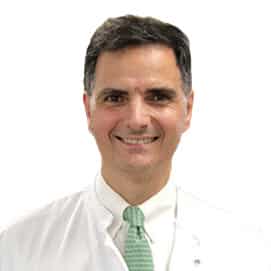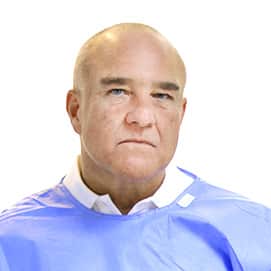After the diagnosis of uterine cancer is established and the extent of the spread of the tumor process is preliminarily determined, as a rule, treatment is planned within the framework of an interdisciplinary oncological conference, that is, together with gynecologists, anesthesiologists, pathologists, and also with radiologists.
Here, during the discussion, a decision is made on the implementation of short and long-term treatments. Which therapy will be carried out in this particular case will depend on the type, location and size of the tumor. And also when choosing methods, the age of the patient and her general state of health are taken into account.
The most important and decisive treatment for uterine cancer in Germany is surgery.
Its goal is to completely remove cancerous tissue and thereby achieve a cure. Radiation therapy is supposed, first of all, when it is impossible to perform an operation for health reasons or it is undesirable. In exceptional cases, radiation therapy is also carried out after surgical treatment (adjuvant radiation therapy) in order to reduce the risk of local recurrence.
If the tumor has already spread far by the time of diagnosis and is no longer curable by surgery and / or radiation therapy alone, then forms of treatment that act throughout the body are prescribed: hormonal or chemotherapy. The goal is to stop the spread of the tumor and reduce the complaints associated with the tumor process. However, chemotherapy is now increasingly being used in curable situations as an alternative to postoperative radiotherapy.
Mdrug therapy for early uterine cancer
The treatment of uterine cancer in Germany with drug therapy that preserves the patient's fertility is the method of choice in young patients who still have a desire to have a child, with a slightly modified tumor (progesterone receptor-positive) at an early stage FIGO1a with limited area mucous membrane of the uterus (without ingrowth into the muscular layer of the uterus). In this case, hysteroscopy and laparoscopy should also be performed to exclude a far advanced stage.
However, patients should be advised that, due to the high risk of recurrence, follow-up examinations should be carried out at short intervals. Therapy is carried out with the so-called gestagen for at least three months. After that, a repeated hysteroscopy and curettage is performed. In the absence of pathology, the patient needs to become pregnant in the near future. Due to the high risk of recurrence, an appropriate operation should be performed after the end of the pregnancy.
Operation
Also, the treatment of uterine cancer in Germany is carried out by a surgical method. The main goal is to completely remove tumor tissue, as well as cancer cells from the affected lymph nodes, in order to achieve a sustainable cure. The volume and technique of the operation depend on the type and prevalence of the cancerous process. How widespread the disease is, most often more accurately can only be assessed during surgery. The operation can be performed through an incision in the abdomen or by laparoscopy.
The operation is unequivocally performed with the complete removal of the uterus (hysterectomy). Because The ovaries are the site of estrogen production, and the fallopian tubes and ovaries must always be removed (oophorectomy). If there is a very small tumor limited to the inside of the uterus, with a low grade (G1 or G2), then this operation is sufficient. In other cases, the surrounding lymph nodes (in the pelvic area / near the aorta) are additionally removed if it is a rapidly growing and especially malignant tumor (G 3), and there is a suspicion that the outer wall of the uterus is affected (pT1b and more). If adjacent organs, such as the bladder and rectum, are also affected, it may be necessary to remove these organs as well, partially or completely. In certain forms of tumors (serous / clear cell carcinoma), the so-called greater omentum must also be removed, in the form of an “apron” of adipose tissue covering the front of the large and small intestine (omentectomy).
In some cases, the operation can be performed laparoscopically (minimally invasive, endoscopically), i.e. without cutting the abdomen (laparotomy). A lower complication rate in the short term has been proven here. Thus, in the case of a disease with a low level of risk (low-risk), this technique can be applied. The long-term therapeutic result is probably equivalent here.
If the tumor is detected at an early stage, then, as a rule, only surgery is sufficient as the only type of therapy. The prospects for a full recovery in this case are very good. For certain local lesions or advanced stages of the disease, radiation therapy (adjuvant radiation therapy) is often performed after surgery in order to destroy any remaining tumor cells in the body and thereby reduce the risk of recurrence of the disease.
Radiation therapy
If the tumor analysis data showed certain characteristics or the disease had already gone far by the time of diagnosis, then the treatment of uterine cancer in Germany is carried out by a combined method: surgical treatment and radiation therapy. However, at low risk, radiotherapy after surgery is not indicated.
Radiation therapy may be performed instead of surgery when surgery, for example, for health reasons, is impossible or undesirable. Radiation therapy is used to reduce the risk of recurrence (adjuvant radiation therapy). The goal of radiation therapy is to kill malignant cells. In order to achieve this, irradiation is carried out from the inside and, in exceptional cases, also from the outside. With the so-called short-range irradiation (brachytherapy), the radiation source is placed in the vault of the vagina or - if no operation has been performed - in the uterine cavity and left there for a short time until the desired dose of radiation is reached. At the same time, radiation remains limited and thus does not damage neighboring organs. Irradiation from the inside in many patients is carried out to protect against recurrence of the disease in the vaginal area. In addition to this, powerful electromagnetic waves can be irradiated outside the entire pelvic area, possibly also in the area of large blood vessels (external or percutaneous irradiation). This is carried out mainly with the defeat of a large number of lymph nodes or with an advanced tumor process.
hormone therapy
Treatment of uterine cancer in Germany: In some patients with advanced endometrial cancer, antihormonal therapy is considered as an alternative or in addition to surgery and radiation therapy. In this case, a progestogen is prescribed in a high dose. This female sex hormone acts as an estrogen antagonist not only to suppress the growth of the lining of the uterus (endometrium), but also often inhibits the growth of tumors that originate from the endometrium. Sometimes with the help of treatment with gestagens, it is possible to reverse the disease and achieve relief from complaints associated with the tumor process. Antihormones such as tamoxifen or a pure antiestrogen, fulvestrant, may also be given. Side effects disappear after the end of therapy and, in general, are less pronounced than with other methods of treatment in such a case.
Chemotherapy
The goal of chemotherapy is to kill cancer cells throughout the body with drugs that inhibit cell growth (cytostatics). Cytostatics work very well against fast-growing cells. Rapid growth is a feature that is especially characteristic of cancer cells.
However, cancer of the body of the uterus, due to its characteristics, does not always respond well to treatment with cytostatics. Adjuvant chemotherapy in curable cases today often precedes radiation therapy or is given as an adjunct. For patients with an advanced stage of the disease (from IB), as well as for patients with a special, especially malignant type (G3, serous / clear cell carcinoma), adjuvant chemotherapy with a so-called platinum derivative makes sense. The optimal combination therapy is the combination of carboplatin with paclitaxel.
However, chemotherapy serves primarily to treat metastases and to alleviate the condition of the patient (palliative therapy). It is prescribed mainly when there is progression of the disease under the influence of antihormonal therapy or when the tumor lacks receptors for hormones.
How is relapse treated?
Approximately 25 % patients, depending on the first stage of the disease, relapse or metastasize. With cancer of the body of the uterus, relapses occur most often in the upper part of the vagina or pelvis. They are treated, if possible, by a new operation, radiation therapy if they have not been done before, or by a combination of both methods. If possible, surgical treatment should be preferred. If surgery or radiation therapy is no longer possible, then antihormonal or chemotherapy therapy may be used to slow down the tumor process and to alleviate the anxiety associated with the tumor process. Recovery in this case is no longer possible.
For carcinomas with hormonal receptors (estrogen and/or progesterone receptor carcinomas) and asymptomatic metastases, gestagen therapy is recommended. If the process is progressing, the treatment of uterine cancer in Germany for receptor-negative tumors and for symptomatic life-threatening cancers may be justified by chemotherapy. The active substances here are primarily anthracyclines, platinum derivatives and taxanes. Due to the limited effects on overall life expectancy, combined chemotherapy (administration of several substances) is prescribed strictly according to indications.
Head of the Clinic of Oncology, Hematology and Palliative Medicine
Head of the Clinic for General, Visceral, Thoracic and Endocrine Surgery
Head of the Clinic for Radiation Therapy and Radiological Oncology
Video
Request appointment
Useful links
Photo gallery












